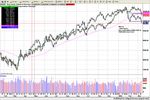Was that a Dow Theory sell signal?
Just to complicate matters, Richard Russell thinks so but others claim there hasn't been a proper bounce of the lows to qualify:
If you want to learn more read the CBS marketwatch story on Dow theory signal:
http://cbs.marketwatch.com/news/story.asp?guid={F12D893A-486C-48EE-89BF-14E21467C236}&siteid=mktw&dist=nbs
Was that a Dow Theory sell signal? By Mark Hulbert, CBS.MarketWatch.com
Last Update: 12:01 AM ET Mar 12, 2004
ANNANDALE, Va. (CBS.MW) -- The stock market may have generated a Dow Theory sell signal this past Wednesday.
I use the word "may" because only one of the three Dow Theorists tracked by the Hulbert Financial Digest believes that such a sell signal was generated. The other two remain bullish.
How can such disagreement exist among devotees of this venerable market timing system, which arguably is the oldest of any of the major market timing systems in widespread use today?
Therein lies a tale.
Ambiguity exists because the Dow Theory's creator never codified it into a set of objective rules. It was introduced over a 30-year period at the beginning of the last century in editorials in the Wall Street Journal.
Those editorials were written by William Peter Hamilton, then the editor of that newspaper, on the basis of conversations he had with Charles Dow, the founder of Dow Jones & Co., the newspaper's publisher.
Hamilton's editorials leave lots of room for followers to argue over the more esoteric points of the theory.
To be sure, there is broad agreement on its general outlines. If both the Dow Jones Industrials Average ($INDU) and the Dow Jones Transportation Average ($TRAN) jointly reach significant new highs, the stock market is likely to continue rising. Similarly, the market is likely to continue falling if both averages jointly reach significant new lows.
At a conceptual level, many Dow Theorists also agree on the three prerequisites for what it takes to signal a change in the market's trend. Consider what those three steps must be when the trend changes from bullish to bearish:
Step No. 1: Both Dow Averages must undergo a significant correction from joint new highs.
Step No. 2: In their subsequent rally attempt following that correction, either one or both of the Averages fail to rise above their pre-correction highs.
Step No. 3: Both Averages must then drop below their respective correction lows.
Richard Russell, editor of Dow Theory Letters, thinks the last of these three pieces fell into place on Wednesday.
Here's his rationale. From their January highs (set on Jan. 26 for the DJIA and Jan. 22 for the DJTA), both averages suffered a correction that lasted until Feb. 4, when the DJIA closed at 10,470.74 and the DJTA closed at 2,822.11. That fulfilled Step No. 1.
Step No. 2 was satisfied by the rally that began from those Feb. 4 lows, since in that rally only the DJIA rose above its January high. The DJTA did not.
Then, this past Tuesday, the DJIA closed below its Feb. 4 low, followed on Wednesday by the DJTA. That was Step No. 3.
Based on this, Russell believes that the market rally that began in October 2002 is now over.
Russell's track record makes it hard to disagree with him. His market timing performance since 1980, when the Hulbert Financial Digest began tracking newsletters, places him at or near the top on a risk-adjusted basis.
The reason there is room for disagreement about Russell's interpretation is that Hamilton was not precise about how serious a correction is needed to satisfy Step No. 1. Not every correction will do, of course, since some corrections last only a couple of hours, while others last weeks or months.
Some other Dow Theorists believe that the late January/early February correction was neither long enough nor deep enough to qualify. For the DJIA, that correction lasted only 7 days and shed just 2.2 percent from the average's value. For the DJTA the correction was only marginally longer (9 days) and deeper (8.4 percent).
And if that correction doesn't qualify, then no sell signal was generated on Wednesday -- leaving intact the last signal that was generated by the Dow Theory.
Both of the other Dow Theorists the HFD tracks -- Richard Moroney of Dow Theory Forecasts, and Jack Schannep of TheDowTheory.com -- believe that this last signal was a buy signal. They therefore remain bullish.
So there you have it -- one Dow Theorist bearish, two bullish.
Why, oh why, couldn't Hamilton have been clearer?

